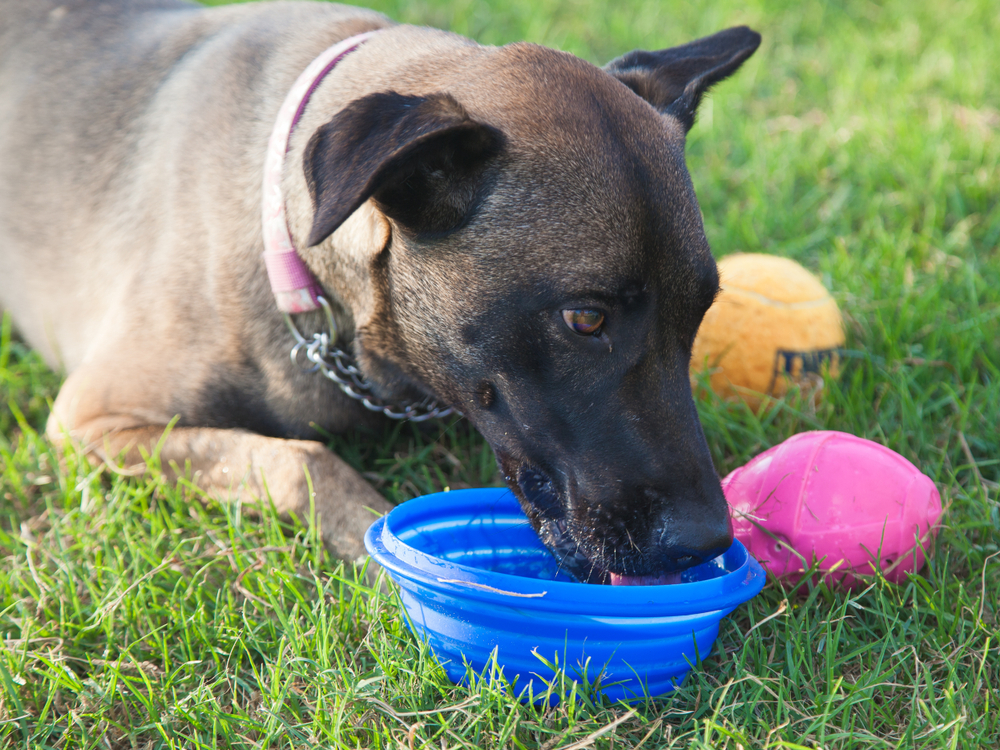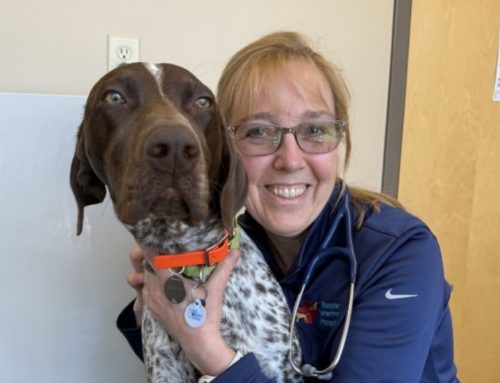You are ready for your trip to the beach. You have applied your sunscreen, donned your sunglasses, and filled your insulated water bottle to the brim. But, before you take your dog along for the day, preparations need to be made for them, as well. Our team at Bassler Veterinary Hospital has enlisted Gabe the golden retriever, a frequent beach goer, to suggest tips that will ensure you and your pet stay safe while soaking up the sun.
Gabe’s the golden retriever’s tip #1: “Before heading out, ensure your dog can manage the heat. Many of my friends cannot handle the heat. Buddy the bulldog and Charlie the chow chow would rather stay home lying on the air conditioner vent than venture out for a day at the beach.”
Bassler Veterinary Hospital: Dogs cannot cool themselves as well as humans, since they have fewer, more sparsely located sweat glands. They must rely on less effective means, such as panting, to cool down, meaning they are more susceptible to overheating. Senior dogs, puppies, overweight dogs, and dogs affected by a health issue are more prone to heatstroke. Brachycephalic breeds, such as chow chows, bulldogs, and boxers, are also predisposed to heat management problems, because their facial structure inhibits their ability to pant effectively. If you have any questions about your dog’s ability to tolerate the heat, bring them to Bassler Veterinary Hospital for a wellness check before setting off for the beach.
Gabe’s tip #2: “Bring bottled water and a water bowl and offer your dog frequent drinks. After chasing seagulls and sandcrabs, a dog can get really thirsty!”
BVH: Dehydrated dogs are more susceptible to heatstroke, so ensure fresh water is available for your dog. If your dog is thirsty enough, they may be tempted to drink the salt water, which can lead to serious, life-threatening issues.
Gabe’s tip #3: “Ensure your dog takes frequent breaks to rest and cool down. I get so excited at the beach, and sometimes I do not realize I am getting overheated.”
BVH: Taking dips in the water is a good way to help your dog beat the heat, but getting them to a shady spot is recommended, especially during the hottest time of day. If your destination will not have readily available shade, consider taking a thick umbrella so you and your dog can escape the sun.
Gabe’s tip #4: “Remember that your dog walks on their bare feet, and hot pavement can cause burns.”
BVH: Your dog’s feet may be covered by the thickest skin on their body, but they are not impervious to hot surfaces. As blacktop, asphalt, and sand absorb the sun’s rays throughout the day, they can become extremely hot, and can cause painful paw pad burns. Before setting out on your daily walk, put your palm against the ground. If you cannot comfortably keep your hand in contact with the surface for five seconds, it is too hot for your dog’s paws. Stick to the grass, or exercise first thing in the morning, before the pavement heats up.
Gabe’s tip #5: “Know what signs indicate heatstroke in your dog. My human does not always realize when I start to overheat.”
BVH: If your dog starts to overheat, they initially may be only a little lethargic and start panting excessively. If they are not cooled down promptly, and their body temperature continues to rise, you may observe signs that include excessive panting and drooling, diarrhea, vomiting, seizures, and collapse. Heatstroke is a serious veterinary emergency for your dog. Their increasing body temperature causes brain inflammation, resulting in bleeding, swelling, and necrosis. Heart damage causes decreased blood circulation throughout the body, leading to shock. Lung tissue injury results in respiratory distress. Acute kidney failure can occur as the kidneys are affected. Also, as the gastrointestinal tract becomes compromised, bacteria can leak across the intestinal wall and cause sepsis. Heatstroke can also precipitate a condition called disseminated intravascular coagulation, which can cause uncontrollable bleeding from multiple sites. Your dog needs emergency veterinary attention.
Gabe’s tip #6: “You must know not only heatstroke signs, but also what to do if your pet overheats. The one time I did experience heat exhaustion, my owner knew what to do to ensure I did not get too sick.”

BVH: If you realize your dog is exhibiting signs that suggest heatstroke, immediately take them to a cool area. A well ventilated, air conditioned area is best. Offer them cool water and, if possible, take their temperature. Normal body temperature for a dog is 101 to 102.5 degrees. Temperatures higher than 105 indicate heatstroke, but temperatures higher than 103 are still concerning. Begin cooling your pet with a tepid water bath. Do not use ice or ice water, since drastic body temperature decreases could result in shock. Once their temperature reaches 103, or if their temperature does not start to decrease after 10 minutes, get them to our American Animal Hospital Association’s (AAHA)-accredited team at Bassler Veterinary Hospital as soon as possible.
You and your dog can have a fun day at the beach by following Gabe’s wise advice. If you are ever concerned that your dog may be suffering from heatstroke, contact our team at Bassler Veterinary Hospital as soon as possible.








Leave A Comment